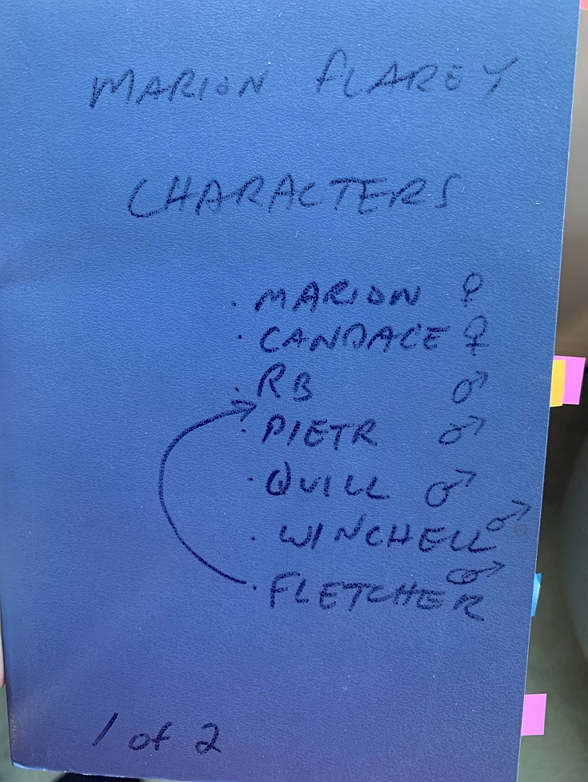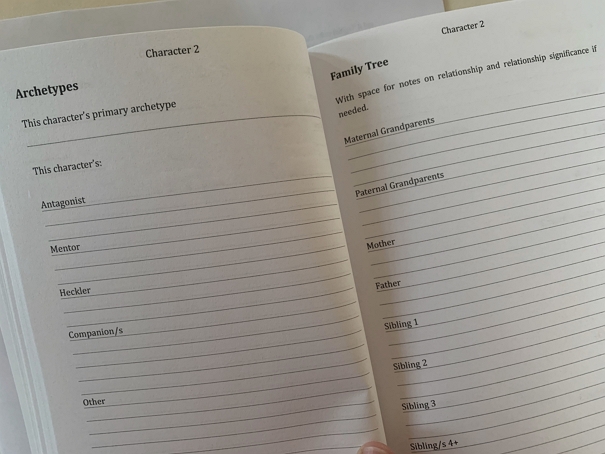I built this guided notebook originally for my own use, to help me create, document, and track characters as I write my novels. Now I’m making my Character Tool for Novelists available to other writers.

I use notebooks to plan and work out my novels. I know not everybody does — some writers do everything electronically. But for me, notebooks work.
One reason may be that I’ve kept journals my entire life. When I sit down with notebook and pen, something happens in my brain. I can ask myself questions and get answers back. It works great for my creative process.
Another reason is that using notebooks gives me a break from screens. I like being able to move around, sometimes, while I’m working on a novel. I like being able to switch from my desk (stand-up) to a chair once in a while.
So the system that I’ve developed over the course of my fiction career (five published novels, a half dozen in process, numerous shorts) is to use blank notebooks — usually around 5-6 x 8 inch size to make it easy to carry around including when I travel — for brainstorming novels, working out problems, and early drafts of key scenes.
When I started work on my Marion Flarey novels (first one, Once Upon a Flarey Tale, available here, second one, Fo Fum Flarey, out now too!) I added something new. In addition to the blank notebooks for general brainstorming, I bought a package of Moleskine Volant journals and dedicated them to working out the characters, using a template that I replicated for every character in the books.

This proved to be a breakthrough for me as a fiction author. I’ve come to appreciate how important it is to fully imagine my characters before I get too deep into drafting an actual novel. It makes them come alive, which helps me enormously with everything else, from plotting and conflict to voice.
Having dedicated character notebooks imposed additional discipline on my planning process. It forced me to go through the foundational work of creating my characters and bringing them to life in my mind. As a result, before I began drafting my first Marion Flarey novel, every major character for all three books was fully developed in my head, including physical appearance, personality, backstory, and their hopes and dreams.
I have no doubt that one reason readers are enjoying Once Upon a Flarey Tale so much is that I “put in the work” on character development.
My dedicated character notebooks also helped me in practical ways. If I forgot a detail about a character — eye color or last name — I could easily look it up. It’s saved me both time and hassle.
But — speaking of saving time! — what I didn’t like about my system was that I was using a blank notebook, which meant I needed to replicate my character template by hand over and over and over.
So I decided to harness my Indie Author skills as a book designer to create and publish a “notebook” that would come pre-printed with the template — and Character Tool for Novelists was born :)
A tool for writers
I published Character Tool for Novelists using Amazon KDP and set the price at $7.99 USD; at 233 pages it’s roughly the cost of a similarly-sized lined journal, and at that price I make around a buck per copy. I chose white paper to make it as bright as possible; I personally wish the paper was a little thicker/higher quality but I’m limited by Amazon’s parameters, and in any case I wouldn’t want to make the tool any more expensive.
The tool has two parts. The (very short) first part provides space to let you list all of your novel’s primary and secondary characters by name, including nicknames/aliases. One section (pictured below) is a straight list of primary and secondary character. Another section is more of a workspace to brainstorm names and track them alphabetically. This ensures you don’t use the same first letter for more than one character (generally a no-no for modern novels).

The second part of the tool comprises the character template itself, with space for 12 characters altogether. Each of the 12 templates includes space for: names and name meanings; family trees; friendships; major life milestones; physical features; dress/clothing styles; personality traits; skills, abilities, and talents; occupations and finances; possessions/properties; social identities; habits, tics, and pet peeves; interests and hobbies; conscious aspirations; unconscious needs; journeys; archetypes; and thematic roles.
Here are a couple more pictures to show you what the interior looks like.



But wait! There’s more! Since many of us need space for more than 12 characters, I’ve also built a companion notebook, Character Tool for Novelists +15. This notebook doesn’t include the part one described above; it comprises only the character template, replicated an additional 15 times. It will be out by the first week of January The USD price is $8.99 since it’s a little longer at 279 pages.

I’d also love writer’s feedback, so if you try the tool, let me know. Have I left enough space for character elements? Should I add sections to the template? Anything else I could do to make the tool more useful?
Thanks for reading!
